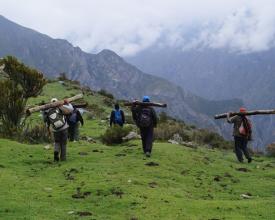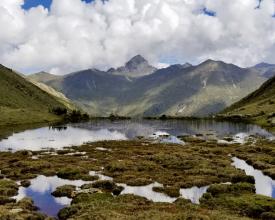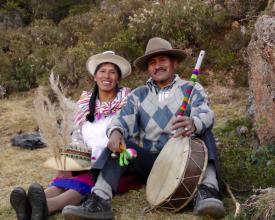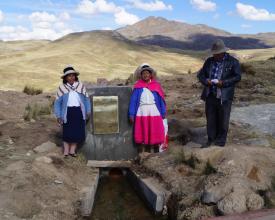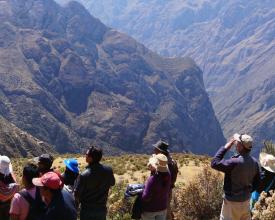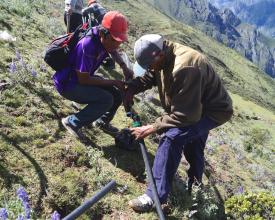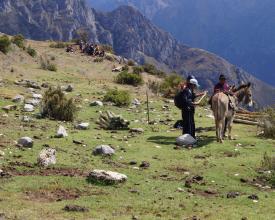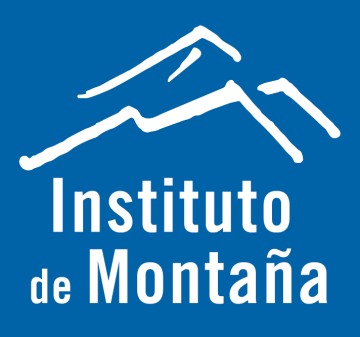
Restoring ancient water management systems in the high Andes as an adaptation to climate change-Miraflores, Peru
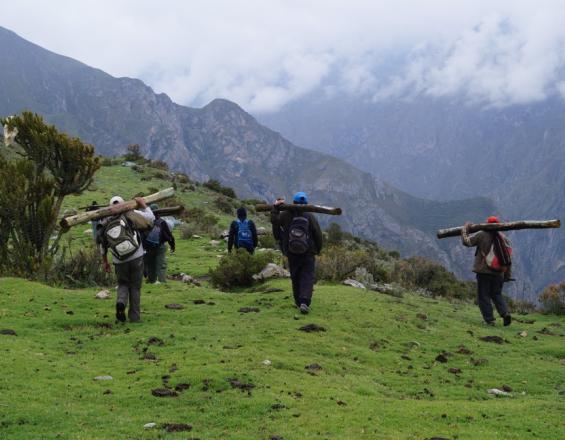
An Ecosystem based Adaptation (EbA) measure was implemented by the community of Miraflores and The Mountain Institute in partnership with the Nor Yauyos Cochas Landscape Reserve and IUCN. Our adaptation solution combined traditional (indigenous), local knowledge with the latest science and comprised three components: (1) Strengthening community organizations and institutions, (2) Strengthening local capacities and knowledge and (3) Combining green and grey infrastructure. Working with conservationists, engineers and anthropologists, Miraflores community members decided to refurbish an ancient water management system designed by their ancestors and dating back as far as 700 years. This renovated system is a hybrid of grey (constructed) and green (from nature) infrastructure that makes the most of ancient engineering and modern science. We were able to restore water flow to native grasslands/pastures and improve livestock and pastureland management--a key adaptation to climate change.
Context
Challenges addressed
Key challenges in the community of Miraflores:
- Weak communal organization
- Low livestock productivity due to degraded pastures and lack of water
- Overall water shortage
- Labor shortages due to migration
- Degraded mountain pastures and wetlands (pre-Inca artificial lagoons) due to overgrazing
- Minimal pasture growth because livestock grazing was not rotated enough to give grasslands time to replenish
Location
Process
Summary of the process
The building blocks contribute to the initiative’s sustainability. The technology-based infrastructure combined with measures to strengthen technical and organizational capacities form the foundation for the measure’s sustainable implementation and maintenance.
Building Blocks
Strengthening community organization and institutions
A pasture and water management plan was developed to promote integrated management of pastures, water and livestock resources throughout the communal territory of Miraflores. The goal was to strengthen community organization so that water could be distributed more effectively and grazing areas could benefit from improved rotation. The process to develop the management plan was facilitated by The Mountain Institute using a methodology to strengthen capacities, stimulating collective and social practices within the community. The plan is defined as a set of ideas that emerge from a given population, based on their own perspectives. This is achieved by means of an in-depth process of analysis. The management plan can also serve as a tool for local management in the medium term.
According to the keen interest of this community, analysis and planning have focused on grasslands and water. The plan also encouraged the community to establish a committee to maintain and operate the renovated water infrastructure so that the water continues to flow and grasslands continue to be irrigated.
Enabling factors
- Local population’s interest and commitment
- Participation of the Nor Yauyos Cochas Landscape Reserve (NYCLR) team
- Commitment and support from the communal and municipal authorities
- Aligned interests between the project and NYCLR, the national authority for protected areas (SERNANP), the community of Miraflores and the municipality
- Participation of local and external experts and useful, positive interactions between them and community members
- Participatory approach, participatory action-research methodology, and effective communication
Lesson learned
- Given the community’s initial lack of confidence in external institutions, the consistent presence of The Mountain Institute field staff and their involvement in the day-to-day life of the community was very important. Communication activities helped to raise levels of trust and participation, as well as local ownership.
- It is essential that the field team be trained in applying the participatory approach, using participatory tools and facilitating collective learning.
- To develop the community’s capacity to handle management plans, it is important to strengthen their links with local and/or regional governments that can foster the community’s initiative and will likely be involved in the plan’s implementation.
- It is important to dedicate even more time to the participatory design and implementation of the pasture and water management plan.
- It's helpful to promote consolidating governance arrangements.
Resources
Strengthening local capacities and knowledge
The main goal of the capacity building and local knowledge component was to provide technical knowledge for managing and conserving water, natural pastures, and livestock. Our focus was on informing community members and park rangers through evaluation workshops and training sessions on topics such as pasture fencing, water management and water distribution. A 3-D model of the Miraflores community was developed in a participatory way to facilitate planning for managing pastures and water in the communal territory. Information was gathered during participatory rural appraisals. These appraisals include specific studies focused on water, pastures, archeology, social organization, agricultural and livestock productivity.
Enabling factors
- Use of communication tools to increase local awareness and understanding of the project
- Local, traditional knowledge and dialogue with outside experts: local participation and positive interactions between locals and external experts have led to effective communications between them
- Participatory approach and participatory action-research methodology
- Local researchers served as a bridge between the project and the whole community
Lesson learned
- It is essential that the field team be trained in applying the participatory approach, using participatory tools and facilitating collective learning.
- Diversifying work with local partners - combining workshops with other methods, practical tools and field work ("learning by doing").
- Develop activities that involve women, youth and other groups within the community.
- Maintain a high level of presence in the field and share the day-to-day work with the community.
- Provide more practical training during fieldwork.
- Communication strategies helped disseminate the project’s ongoing achievements and progress. These updates were well received and had good impact. Examples are the participatory videos and the "Night of Art” theater.
Improvement of gray-green water and grassland management infrastructure
In the infrastructure component, the following actions were carried out:
- expanding the fenced area of the Yanacancha wetland,
- repairing the Yanacancha water pipeline: Curiuna to Huaquis segment.
- sectorization (by fencing) from Curiuna to Tuntinia,
- repairing and constructing five watering places (Curiuna, Wayacaña, Pampalpa, Colulume and Tuntinia), and
- constructing a “water cave” at the entrance to Huaquis.
As we implemented this component, the community contributed their labor through communal tasks. The community was also responsible for transferring construction materials to this remote area.
Enabling factors
- Trust and good relationships were developed between the project team and the community.
- Open, respectful communication as a central component.
- Local interest, participation by the NYCL Reserve managers and commitment and support from communal authorities.
- Solid relationship and effective coordination between The Mountain Institute, the NYCL Reserve managers and the national authority for protected areas (SERNANP).
Lesson learned
- During the planning phase, allocate sufficient time for critical activities such as working on infrastructure, monitoring impact, communications and systematization of results.
- Local labor/ communal work for infrastructure development and/or maintenance might take more time than anticipated.
- Seek commitment and support from local authorities and involve them in key decision-making processes. Build partnerships with local governments, to make the EbA measure more sustainable.
- Present the EbA measure budget to the community and ask locals to contribute. Their contribution can be labor, expertise, equipment, materials and/or funds, etc.
- Carefully analyze possible environmental and social impacts of the EbA measures and develop a strategy for mitigation and risk management.
- Implement EbA measures with an adaptive management approach ("Not everything is done right from day 1"). In other words, plan to adapt as the project proceeds.
Impacts
The area that protects wetlands, lagoons and ancestral dikes in Yanacancha was expanded from 3 to 5 ha. The vegetation cover in the fenced area shows a trend of improvement from 69% to 90%. The pipeline repair increased the water supply, availability and distribution to larger areas. The community of Miraflores agreed to preserve and recover 160 ha of native pasture for eight months annually, during the dry season. The community developed its “pasture and water management plan” in a participatory manner. This plan included long-term activities and identified conservation objectives that are aligned with the objectives in the Nor Yauyos-Cochas Landscape Reserve's master plan. A space for dialogue between various groups—peasant/indigenous communities, governments and government agencies, academia and research, NGOs and the private sector—was created to foster synergies for financing and technical support for sustainably managing grassland ecosystems (with an emphasis on the pasture and water management plan).
Beneficiaries
- Direct: 80 families (approx. 400 people) in the community of Miraflores.
- Indirect: Populations living in the middle and lower part of the watershed.
Sustainable Development Goals
Story
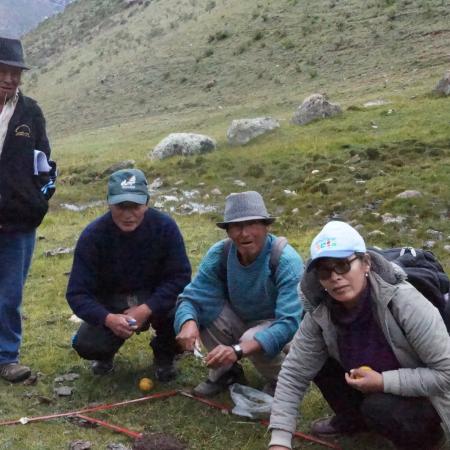
Excerpt from Raúl Crispin Robladillo, park ranger:
At first, ecosystem-based adaptation was something new for us. Working in the area (Nor Yauyos-Cochas Landscape Reserve), we knew about conservation, preservation of natural resources, but we still knew little about EbA. But we became acquainted.
When this project started, it was a bit shocking to us, that the community members could contribute. And that contribution was their manpower. It was not customary. But that makes them appreciate the communal work they have done.
Since this project gives them the possibility of being able to do small fences, water transfer and pasture management, they alsobegin to see that their future activities will be related to that. Working with young people has been important. It is as if they have regained their identity, because in all the work they have done, these young people have learned from their ancestors, understanding how they worked long ago. Thus, they are aware of their history and current life plus how they think about tomorrow. That has been important because the youth play an important role in their homes and sometimes help their parents understand.
I think the organizational issue has improved. Families are already building fences, in order to improve pastures. They know very well that they cannot buy better livestock without (having enough) grass.
Previously, the plans made in the community were unrealistic, non-participatory and had nothing to do with the communities. The grassland and participatory water management plan now developed is important. The people themselves have assumed responsibility and they want it to be implemented, beginning with higher priority actions. They are already planning on ways to address the mayor, asking him to include what the citizens want into participative budgets. And it's not just one person, it's the majority of the community.
We are updating the master plan of the Landscape Reserve and this EbA project is framed within our plan. Park rangers have been trained in pasture evaluation, etc. In the future, they will continue to give technical assistance to community members, since that is framed within what we want as a Reserve. Consequently, they will already have acquired the basic knowledge to be able to replicate the course. And I think that's going to be important to be able to give continuity to all this in the communities.

